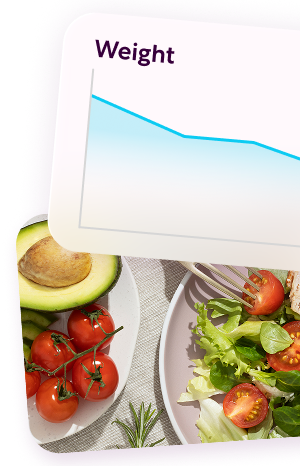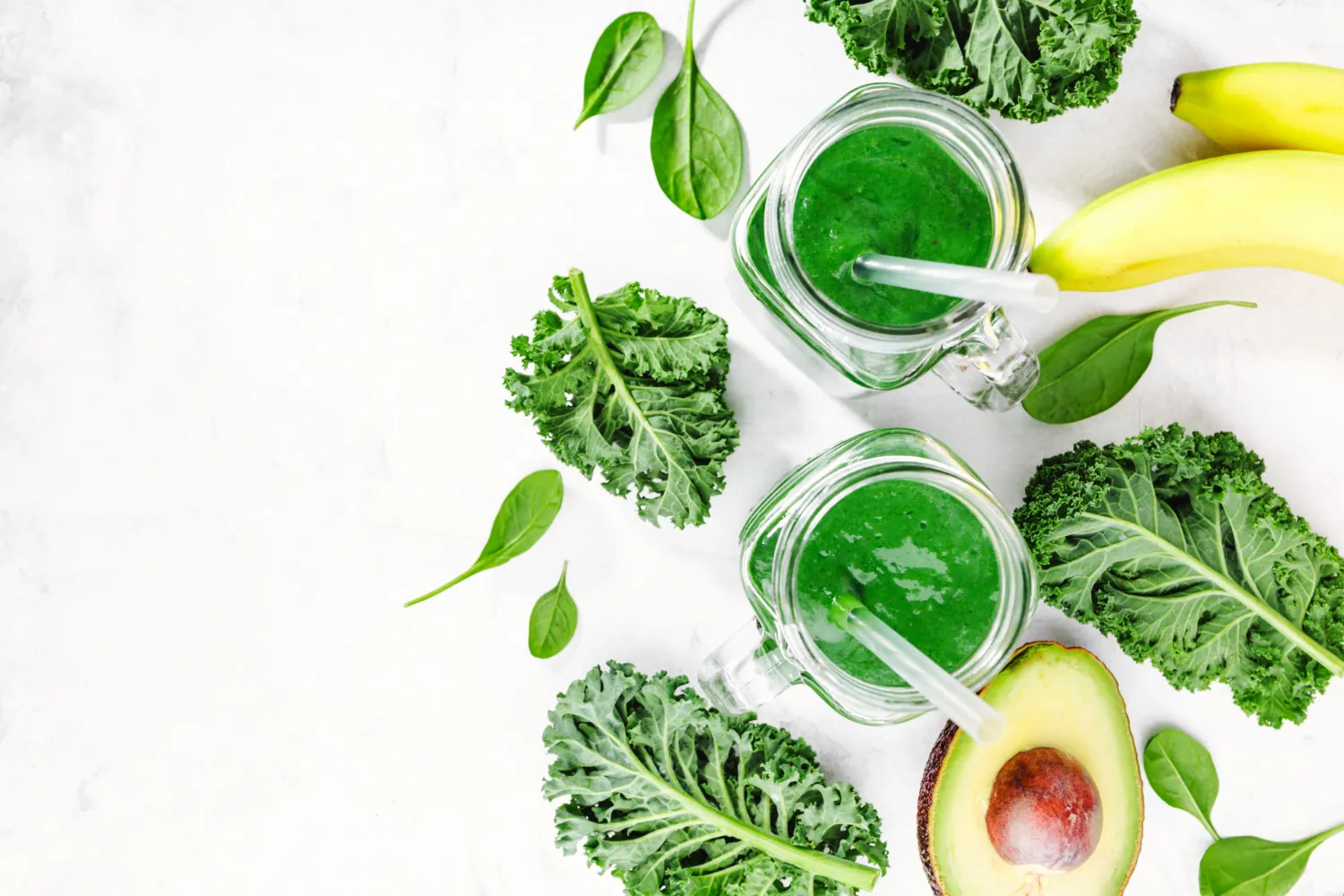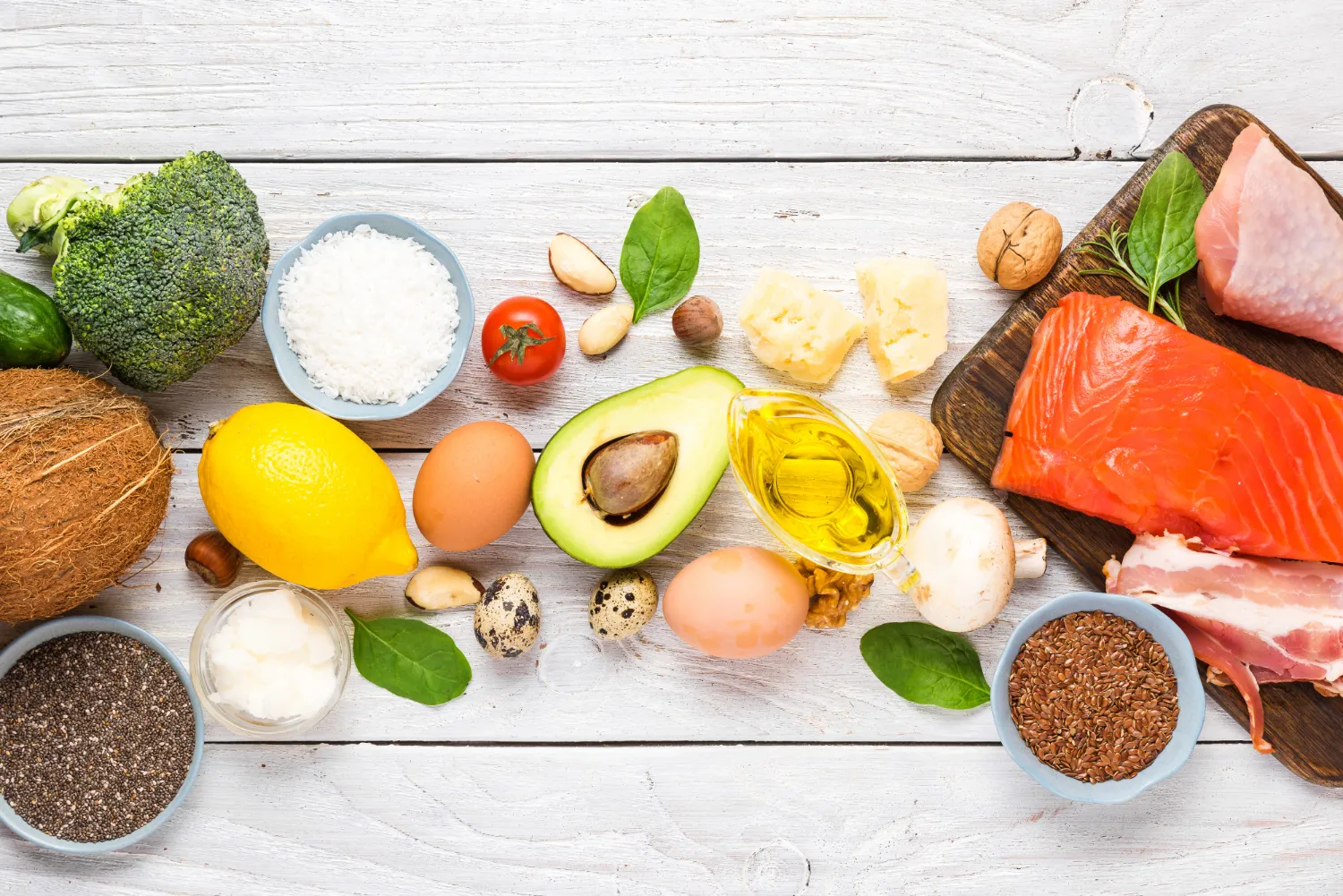Weight loss that fits your goals and your life.
Get your plan
Weight loss that fits your goals and your life.
Get your plan
Menopause Recipes: Delicious and Nutritious Options for Every Meal
Menopause can be a confronting and confusing time in our lives. Besides the night sweats, hot flashes, and sudden mood changes, the increased appetite and weight gain are the final straw.
The last thing we want is to be worried about is adjusting our meals to fit into a low-calorie diet.
Don’t worry — This is something many of us experience, and let us assure you it can be done!
In this article, we are going to cover menopause diet plan recipes, providing you with delicious healthy options for every meal.
Importance of a Balanced Diet During Menopause

As we venture through menopause our physiology is constantly adjusting to the decline of estrogen. A decline in that leads to increased inflammation, appetite, weight, and risk of chronic illness.
Thankfully, many of these symptoms can be addressed in part through nutrition. You see, consuming a balanced diet loaded with essential vitamins and minerals can alleviate menopause symptoms.
Protein and fiber can improve satiety, and omega-3 fatty acids and vitamin B can reduce inflammation.
A balanced diet can help us maintain a healthy weight, meet our nutritional needs, and fill deficiencies caused by menopause.
For a more comprehensive understanding of how to build an effective diet plan, including what to focus on and what to avoid, explore our guide on Menopause Diet Plan .
Key Nutrients for Menopausal Women
When we create menopause diet recipes the key is to add foods that contain menopause symptom-fighting nutrients and vitamins.
This may sound complicated, but let us assure you that it is easier than you think.
Below is a list of essential nutrients, vitamins, and best food sources to combat menopause symptoms.
Calcium
As we progress through menopause and our estrogen levels decline our bone mineral density can be at risk.
We must take a proactive approach and eat calcium-rich food to boost our body's bone health. Food such as low-fat dairy, yogurt, cheese, soy, and spinach are all great sources.
Carbohydrates
Carbohydrates in the form of whole grains, brown rice, and leafy greens will add volume to your meals and give you sustained energy throughout the day.
Whole grains, quinoa, and brown rice have a low glycemic index, providing a steady energy source.
Fibre
Building your menopause diet recipes around foods rich in dietary fiber will add volume to your meals while reducing the effects of cardiovascular disease and gut health.
Fruits, vegetables, oats, and legumes are all excellent sources of fiber that are accessible and easy to add to meals.
Omega-3
Omega-3 is a vital nutrient that combat hot flashes, and night sweats and reduces inflammation. Found in mackerel, salmon, sardines, nuts, seeds, and leafy greens, it is easy to whip up something to combat those dreaded symptoms and improve your overall health.
Phytoestrogen
Phytoestrogen is an estrogen-like compound derived from plants that can be used to maintain estrogen levels. When estrogen declines there is an increased risk of inflammation and chronic illness.
Food including nuts, seeds, fruits, and vegetables containing phytonutrients can be consumed reducing negative health outcomes.
Potassium
Maintaining and boosting your potassium intake is essential when going through menopause. Potassium plays a major role in the body and deficiencies can lead to increased blood pressure, bony turnover, and loss of calcium through urine, which can be detrimental during menopause.
Fortunately, potassium can be found in many foods including meat, poultry, fish, whole wheat, fruit, and vegetables.
Protein
Protein is essential for our menopause diet plan because it keeps us fuller for longer. As our metabolism decreases and our appetite increases we can start to see sudden weight gain, meaning we must prioritize foods that will keep us full.
Protein will also help you maintain lean muscle mass; vital during menopause.
Meals centered around a healthy protein source including, chicken, eggs, soy, nuts, and seeds, will curb your hunger, and stop you from reaching for snacks between meals.
Vitamin D
During menopause, the decrease in estrogen can lead to loss of bone density. Vitamin D-rich foods including salmon, low-fat milk, and soy can help promote calcium absorption and assist with bone remodeling and growth.
Vitamin B
Foods containing vitamin B can be eaten to help regulate your hormones and reduce night sweats and hot flashes. Whole grains, quinoa, oats milk, and soy are all excellent sources of vitamin B that can reduce symptoms and improve your health.
Breakfast Recipes

Let’s kick off your menopause diet recipes with breakfast. Your plan of attack for your first meal of the day is to eat a high-protein meal, to keep you full until lunch.
Below are some of our favorite nutrient-packed breakfast options.
Energizing Smoothies
Easy to prepare, and even easier to eat; smoothies are a game-changer when hitting your nutrient targets.
Berry Spinach Smoothie
Method:
- Add ingredients to blender and blitz until smooth.
Green Goddess Smoothie
Method:
- Add ingredients to blender and blitz until smooth.
Protein-Packed Breakfasts
Have more time for breakfast? Try these protein-packed meals to preserve muscle mass, reduce inflammation, and improve overall health.
Quinoa and Veggie Scramble
Method:
- Add water to a pot, and bring it to a boil
- Add quinoa, boil, and cook at medium for 12 minutes or until water dissolves.
- Add olive oil at medium heat. Toss in mushrooms, red pepper, and spinach, and cook for 10 minutes.
- Scramble eggs and mix them with your cooked vegetables.
- Add quinoa to egg and vegetable mixture, then serve.
Greek Yogurt with Flaxseeds and Berries
Method:
- Scoop in 1 cup of low-fat Greek yogurt into a bowl
- Add ½ cup of blueberries and 1 tablespoon of ground flaxseeds
- Mix until combined
Lunch Recipes

A protein-packed breakfast to sustain energy through the morning. The key is to continue this with a high-fiber, high-protein, low-GI lunch to stop those afternoon cravings.
Below are some of our favorite menopause diet lunch recipes.
Light and Refreshing Salads
Kale and Quinoa Salad with Lemon Dressing
Method:
- Begin by rinsing your quinoa and add it to a pot of boiling water.
- Once it reaches boil reduce heat to low for 12 minutes or until water dissolves.
- Add chopped kale, chickpeas, red pepper, broccoli, and mix in cooked quinoa.
- Whisk dressing ingredients in a separate bowl and add to salad.
- Toss until mixed through.
Chickpea and Avocado Salad
Method:
- Combine diced cucumber, tomatoes, sliced red onion, and drain chickpeas in a large bowl.
- In a separate bowl combine lemon juice, olive oil, chopped herbs
- Add avocado and dressing to the salad, and mix well.
Hearty Soups and Stews

Lentil and Vegetable Soup
Method:
- Place all ingredients into a large pan and add 1 ½ boiling water
- Cover and allow it to simmer for 30 minutes until your lentils and vegetables are tender.
- Serve in a medium to large bowl
Chicken and Sweet Potato Stew
Method:
- In a large pot fry diced onion and 2 tablespoons of olive oil.
- Add chicken broth, tomatoes, black beans, smoked paprika, and spinach.
- Reduce heat and add sweet potatoes (cook for 15 minutes)
- Once the sweet potato is through, mash the soup using a masher.
- Add 2 cups of chicken, parsley.
- Wait until the chicken is warm, then serve.
Dinner Recipes
You’ve made it through the day without giving in to your cravings. Now it’s time to finish off your day with some delicious vitamin and nutrient-rich meals.
Balanced Main Courses
Baked Salmon with Asparagus
Method:
- In a medium baking dish add asparagus to create a base for your salmon.
- Add olive oil and salom directly on top of your asparagus.
- Dress with garlic, lemon, and rosemary.
- Cook at 400°F for 20 minutes until asparagus is cooked.
- Serve with fresh herbs and lemon juice.
Stuffed Bell Peppers with Quinoa and Black Beans
Method:
- Preheat over to 350 degrees F.
- Cut the tops off your bell peppers.
- Mix cooked quinoa, chopped bell pepper tops, cheese, pasta sauce, and coriander in a bowl.
- Pack bell peppers with the mixture and place in a baking dish.
- Cover with foil and back for 30 minutes until peppers are soft.
- Serve.
Comfort Foods with a Healthy Twist
Cauliflower Crust Pizza
Method:
- Grate cauliflower and place in the microwave for 4-5 minutes until soft.
- Drain moisture out using a nut milk bag.
- Mix your cheese, cauliflower, egg, and seasoning in a bowl.
- Spread the cauliflower onto a baking tray and bake for 25 minutes at 375 F.
- Remove from the oven, add your toppings, and then place back into the oven for 10 minutes.
- Serve.
Zucchini Noodles with Pesto
Method:
- Slice your zucchini into noodles using a julienne peeler.
- To make your pesto add olive oil, garlic, basil, cheese, lemon juice, and blitz until smooth.
- Mix your noodles and pesto until coated and top with cherry tomatoes.
Snack Options

Here are some healthy snack options to keep you full between those delicious main meals.
Nutritious and Satisfying Snacks
Almond and Seed Energy Balls
Method:
- Add almonds to blender and blitz until chopped, and then place to the side.
- Blitz dates until they are smooth (add hot water if necessary).
- Add almonds, pumpkin seeds, coconut, sunflower seeds, and cranberries and blender until the ingredients are mixed.
- Remove the mixture using a spoon, shape it into balls, and refrigerate for one hour. Serve.
Dark Chocolate and Nut Clusters
Method:
- Place dark chocolate in a bowl and microwave for 30 seconds until melted.
- Add almonds to melted chocolate and mix through.
- Using a tablespoon, portion clusters onto a baking sheet.
- Refrigerate for 30 minutes. Serve.
Tips for Successful Meal Planning
The success of your menopause diet comes down to proper planning. Here are our best tips to ensure you a long-term change.
Creating a Weekly Meal Plan
One of the best things you can do to ensure the success of your menopause diet is to create a weekly plan.
When we are busy, tired, and battling menopause symptoms, the last thing we want to do is figure out how to cook a healthy meal.
Creating a weekly meal plan and doing a weekly shop takes the guesswork out of meal time. Ensuring the pantry and fridge are full of healthy, nutritious food which will help you stick to your menopause diet.
Preparing Ingredients Ahead of Time
Preparing your ingredients ahead of time is another way to make mealtime easier. Sure, many of us like cooking, but having to peel, chop, slice, and dice our food when we are busy or tired is as good an excuse to order takeout.
Prepping your ingredients and meals in advance removes this barrier, making it a little easier each day to whip up a healthy option.
Incorporating Variety and Seasonal Foods
Incorporating a variety and seasonal foods is one of the best ways to help you adhere to your menopause diet.
Often when we change to healthy options we can become complacent and start to cycle through the same foods, making it difficult to stick to our plan.
Adding variety, different recipes, and seasonal food can make mealtime interesting. This combined with the weekly shop will help you explore different healthy options, ensuring the long-term success of your menopause diet.
Addressing Common Concerns
Making the shift to eating healthy nutritious meals is far from easy, as
Managing Cravings
One of the biggest issues we face during menopause diet is how we manage cravings. Cravings have always been unpredictable, and now the addition of hormonal changes makes it that much harder.
The best way to manage those cravings is to plan your meals and remove unhealthy options from your environment.
Each meal should have a lean source of protein, and fiber which can improve satiety. While removing sugary snacks, and processed food can remove temptation, and push you toward your ready-made healthy option.
Ensuring Nutritional Balance
When we begin our menopause diet many of us can get fixated on maintaining a nutritional balance, as we want to ensure that we get exactly what we need to fight symptoms.
Don’t worry — it's easier than you think.
If you refer back to our key nutrient table, you will notice many foods cover a range of different vitamins and nutrients.
What’s great about this is you can mix and match various foods and try different recipes and still get a dose of those symptom-fighting nutrients.
A good rule of thumb is to aim for a colorful plate with a wide variety of fresh fruit, vegetables, nuts, and seeds. Combine this with a lean source of protein and you will be well on your way to ensuring nutritional balance.
Adapting Recipes for Dietary Restrictions
One of the biggest concerns people have when they begin their menopause diet is whether it will suit their dietary requirements.
Fortunately, many of the meals we have listed a fresh healthy options, that can easily be modified to match any requirement.
If you are vegan or vegetarian, add more protein through soy, nuts, and seeds. Or if you are celiac, remove whole wheat foods.
Because many of the ingredients are whole foods, little has to change to make them suit your dietary needs.
Conclusion
Changing to a menopause diet can seem like a step back as you reduce your calorie intake and remove the processed food.
However, we truly believe that it is an exciting time when you can discover just how good eating delicious, whole foods can be not only for reducing the symptoms of menopause but for overall health and well-being.
If you are thinking about making the change, we recommend starting slow. Focus on removing low-quality processed foods from your diet, add protein, and plan ahead.
Weight loss that fits your goals and your life.
Get your plan
Sources
FAQs
What is a menopause diet plan, and why is it important?
A menopause diet plan focuses on nutrition that supports hormonal balance and alleviates symptoms like hot flashes and mood swings. It emphasizes whole foods, healthy fats, and adequate calcium and vitamin D to promote overall health during this transition.
Where can I find more menopause-friendly recipes?
You can find menopause-friendly recipes on health blogs, cookbooks focused on women's health, and nutrition websites. Many resources offer meal plans and recipe collections specifically designed to support women during menopause.
Are there specific foods I should avoid during menopause?
Yes, it's advisable to limit caffeine, alcohol, and spicy foods, as they can trigger hot flashes and disrupt sleep. Additionally, reducing sugar and refined carbohydrates can help manage weight and mood swings during menopause.
What types of recipes are included in a menopause diet plan?
A menopause diet plan includes recipes rich in phytoestrogens, fiber, and healthy fats. Expect dishes featuring whole grains, legumes, fruits, vegetables, and lean proteins. These recipes aim to support hormonal health and provide essential nutrients.
How can I adapt my current diet to align with menopause dietary recommendations?
To adapt your diet, start by incorporating more fruits, vegetables, and whole grains while reducing processed foods and sugars. Focus on foods high in calcium and vitamin D, and consider adding phytoestrogen-rich foods like soy products and flaxseeds to your meals.






